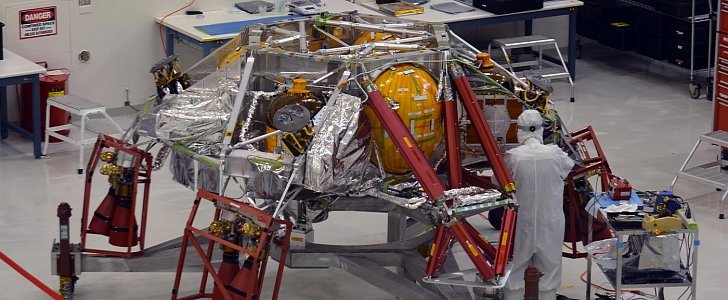Probably the longest assembly process of a man-made machine in recent times has begun at JPL's Spacecraft Assembly Facility High Bay 1 in Pasadena. California. Of the thousands of components of the facility floor, some will take the shape of the next Martian rover.
To be launched in 2020 aboard an Atlas V 541 rocket, the new rover will be used to conduct preparatory work for the yet unscheduled arrival of humans. That includes geological assessments of its landing site, assessment of the habitability of the environment, searching for signs of ancient Martian life, and tracking natural resources and hazards.
With the rover, humans would be sending back to Mars a space rock weighing 8.58 kg, found in Oman in 1999 and believed to have originated from the Red Planet. The meteor would become part of the rover’s Scanning Habitable Environments with Raman and Luminescence for Organics and Chemicals (SHERLOC) instrument.
The assembly process of the rover, its spacecraft and the landing module would last a year-and-a-half. Work on the project would mean adding avionics, power, telecommunications, mechanisms, thermal and navigation systems.
"Parts of this mission are coming from the other side of the world, and some are coming from just 'down the street' in Pasadena, and some are coming from literally down the street - a couple of buildings away,” said David Gruel, Mars 2020 mission assembly manager.
"Right now we are working the descent stage, and by fall we expect to be working on the rover itself."
Right now, planet Earth has three rovers on Mars: Opportunity, its sibling Spirit, both part of the same mission, launched in 2003, and Curiosity, launched in 2011. After losing contact with Spirit in 2010, only Opportunity and Curiosity are left active.
The new Mars rover measures 10 feet long (3 meters), 9 feet wide (2.7 meters), and 7 feet tall (2.2 meters). Being the size of a small car, it is a bit bigger than the vehicles currently on site.
With the rover, humans would be sending back to Mars a space rock weighing 8.58 kg, found in Oman in 1999 and believed to have originated from the Red Planet. The meteor would become part of the rover’s Scanning Habitable Environments with Raman and Luminescence for Organics and Chemicals (SHERLOC) instrument.
The assembly process of the rover, its spacecraft and the landing module would last a year-and-a-half. Work on the project would mean adding avionics, power, telecommunications, mechanisms, thermal and navigation systems.
"Parts of this mission are coming from the other side of the world, and some are coming from just 'down the street' in Pasadena, and some are coming from literally down the street - a couple of buildings away,” said David Gruel, Mars 2020 mission assembly manager.
"Right now we are working the descent stage, and by fall we expect to be working on the rover itself."
Right now, planet Earth has three rovers on Mars: Opportunity, its sibling Spirit, both part of the same mission, launched in 2003, and Curiosity, launched in 2011. After losing contact with Spirit in 2010, only Opportunity and Curiosity are left active.
The new Mars rover measures 10 feet long (3 meters), 9 feet wide (2.7 meters), and 7 feet tall (2.2 meters). Being the size of a small car, it is a bit bigger than the vehicles currently on site.

